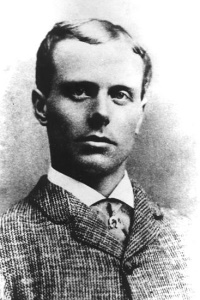

James Albert Bonsack (4 October 1859–2 June 1924), businessman and inventor of the cigarette-rolling machine, was born at Bonsack in Roanoke County, the son of Jacob Bonsack and Sarah Whitmore Bonsack. His father operated the Bonsack Woolen Mill on the road between Salem and Lynchburg. James Bonsack gained his early knowledge of machinery there.
In 1876 Bonsack saw an announcement that the tobacco firm of Allen and Ginter in Richmond had offered a prize for the first machine able to roll and cut a complete cigarette. Bonsack and his friends decided to work on the project, but only he had sufficient mechanical ingenuity. The challenge soon became an obsession. Having completed his early education under a Roanoke schoolmaster, Bonsack entered Roanoke College in 1878, only to leave after one year to set up a workshop in his father's mill. The decision proved fortuitous when the carding machine in the mill inspired the solution to one of his most difficult problems, how to measure the tobacco consistently and accurately. Bonsack initially planned to use a tapered tube to form the cigarette paper into a cylinder but then learned that a New Yorker had patented a similar but ineffective device in 1876. Bonsack's father then paid a reported $18,000 for the rights to the earlier patent. James A. Bonsack completed his design with a complicated blade that cut the cylinder into cigarettes of uniform length. He filed for a patent for his cigarette-rolling machine on 4 September 1880 and received patent number 238,640 on 8 March 1881.
Bonsack soon had a completed machine ready to ship to the Allen and Ginter factory in Richmond, but fire destroyed it while it was on a freight car at Lynchburg. Insurance money enabled him to build a second, improved device, which was tested at Allen and Ginter in June 1881. In March 1882 he chartered the Bonsack Machine Company to manufacture the Bonsack Cigarette Machine. The family attorney, Demetrius B. Strouse, was president, with Jacob Bonsack and James A. Bonsack among the trustees. They applied for foreign patents in order to license overseas manufacturers, and in 1882 Bonsack went to Rome to direct the installation of the first European machine. Two years later, seven were operating in the United States, and an equal number, manufactured under license in France, had been built in Europe.
The Bonsack Machine Company prospered from the first. One machine could produce as many cigarettes as forty-eight people could make manually. The early machines were very complicated devices and not without problems. A mechanic employed by the manufacturer directed the operations of the machines. An exceptionally able mechanic, William Thomas O'Brien, made improvements to the two machines installed at the W. Duke, Sons, and Company factory in Durham, North Carolina, enabling that factory to produce up to four million cigarettes a day.
The modern cigarette-manufacturing industry traces its development directly to Bonsack's machine, which produced inexpensive cigarettes at a time when cigarette smoking was growing in popularity. Ironically, through the mid-1880s Allen and Ginter declined to employ the device throughout their factory and continued to market more expensive hand-rolled cigarettes, losing much of the mass market in the United States to North Carolina manufacturers, especially W. Duke, Sons, and Company, and the European market to tobacco companies operating Bonsack machines there under license from the manufacturer.
The invention brought Bonsack wealth. He moved to Marietta, Pennsylvania, where on 1 February 1883 he married Anna Musser. They had two sons and one daughter and had moved to Philadelphia by the end of the decade. Until 1901 Bonsack continued to improve his cigarette machine, replacing the solid cylinder-forming tube with an ingenious series of inclined belts and obtaining more than a dozen patents for tobacco feeds, tube pasters, and cigarette cutters. The royalties from his inventions appear to have been the major source of family income, enabling him to join the Philadelphia Country Club and other socially prominent organizations. James Albert Bonsack died of apoplexy in the vault of a Philadelphia bank on 2 June 1924 and was buried at West Laurel Hill Cemetery in nearby Montgomery County.
Sources Consulted:
James Evans Bonsack, "A Sketch of the Early Life of James Albert Bonsack Including a Brief Account of the Invention of the Bonsack Cigarette Machine," typescript dated 30 Nov. 1938, Nannie May Tilley Papers, David M. Rubenstein Rare Book and Manuscript Library, Duke University, Durham, North Carolina; Nannie May Tilley, The Bright-Tobacco Industry, 1860–1929 (1948), 570–577 (portrait following 402); other accounts of varying accuracy in Lynchburg News, sesquicentennial ed., 11 Oct. 1936, Roanoke Times and World News, 14 June 1947, and Deedie Dent Kagey, Community at the Crossroads: A Study of the Village of Bonsack of the Roanoke Valley (1983), 114–119; obituaries in Philadelphia Record, 3 June 1924, and Lynchburg News, 5 June 1924.
Written for the Dictionary of Virginia Biography by James Mulholland.
How to cite this page:
James Mulholland, "James Albert Bonsack (1859ndash;1924)," Dictionary of Virginia Biography, Library of Virginia (1998– ), published 2001, rev. 2022 (http://www.lva.virginia.gov/public/dvb/bio.asp?b=Bonsack_James_Albert, accessed [today's date]).
Return to the Dictionary of Virginia Biography Search page.


